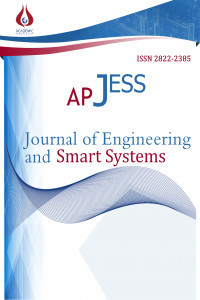Numerical Investigation for Moment-Curvature Relationship of CFRP Jacketed RC Columns
Moment curvature, carbon fiber reinforced polymer, rectangular RC column, fiber model, GNU Octave
Numerical Investigation for Moment-Curvature Relationship of CFRP Jacketed RC Columns
Moment curvature, carbon fiber reinforced polymer, rectangular RC column, fiber model, GNU Octave,
___
- E. Celebi, M. Aktas, N. Caglar, A. Ozocak, M. Kutanis, N. Mert and Z. Ozcan, “October 23, 2011 Turkey/Van-Ercis earthquake: structural damages in the residential buildings”, Natural Hazards, vol. 65, no. 3, pp. 2287-2310, 2013.
- P. Juntanalikit, T. Jirawattanasomkul, and A. Pimanmas, “Experimental and numerical study of strengthening non-ductile RC columns with and without lap splice by Carbon Fiber Reinforced Polymer (CFRP) jacketing”, Engineering Structures, vol. 125, pp. 400–418, 2016.
- A. Hosseini, A. R. Khaloo, and S. Fadaee, “Seismic performance of high-strength concrete square columns confined with carbon fiber reinforced polymers (CFRPs)”, Canadian Journal of Civil Engineering, vol. 32, pp. 569–578, 2005.
- R. D. Iacobucci, S. A. Sheikh, and O. Bayrak, “Retrofit of Square Concrete Columns with Carbon Fiber-Reinforced Polymer for Seismic Resistance”, ACI Structural Journal, vol. 100, no. 6, pp. 785–794, 2003.
- P. Faustino, P. Frade and C. Chastre, “Lateral cyclic behaviour of RC columns confined with carbon fibres”, Structures, vol. 5, pp. 196-206, 2016.
- H. Nakahara and H. Yin, “Self-centering capacity of a structural Frame composed of steel-jacketed concrete columns and steel beams”, Structures, vol. 14, pp. 409-415, 2018.
- Y. H. Chai, M. J. N. Priestley and F. Seible, “Flexural retrofit of circular reinforced concrete bridge columns by steel jacketing - experimental studies”, Report No. SSRP-91/06, San Diego, University of California, 1991.
- G. E. Thermou, V. K. Papanikolaou and A. J. Kappos, “Flexural behaviour of reinforced concrete jacketed columns under reversed cyclic loading”, Engineering Structures, vol. 76, pp. 270–282, 2014.
- M. Soman and J. Mohan, “Rehabilitation of RC columns using ferrocement jacketing”, Construction and Building Materials, vol. 181, pp. 156-162, 2018.
- A. Kaish, M. R. Alam, M. Jamil, M. F. M. Zain and M. A. Wahed, “Improved ferrocement jacketing for restrengthening of square RC short column”, Construction and Building Materials, vol. 36, pp. 228-237, 2012.
- M. N. Youssef, M. Q. Feng, and A. S. Mosallam, “Stress-strain model for concrete confined by FRP composites”, Composites: Part B, vol. 38, pp. 614–628, 2007.
- L. Lam and J. G. Teng, “Stress-strain model for FRP-confined concrete under cyclic axial compression”, Engineering Structures, vol. 31, no. 2, pp. 308–321, 2009.
- U. Ersoy and G. Ozcebe, Reinforced Concrete, Department of Civil Engineering, Middle East Technical University, METU Press, Ankara, 2008.
- U. Ersoy and G. Ozcebe, “Moment-curvature relationship of confined concrete sections”, Technical Journal of Turkish Chamber of Civil Engineers, vol. 9, no. DEC., pp. 549–553, 1998.
- J. W. Eaton, D. Bateman, S. Hauberg, and R. Wehbring, GNU Octave version 4.2.1 manual: a high-level interactive language for numerical computations, http://www.gnu.org/software/octave/doc/interpreter/, 2017.
- Y. Y. Wei and Y. F. Wu, “Unified stress-strain model of concrete for FRP-confined columns”, Construction and Building Materials, vol. 26, no. 1, pp. 381–392, 2012.
- J. B. Mander, M. J. N. Priestley, and R. Park, “Theoretical Stress‐Strain Model for Confined Concrete”, Journal of Structural Engineering, vol. 114, no. 8, pp. 1804–1826, Sep. 1988.
- Yayın Aralığı: Yılda 3 Sayı
- Başlangıç: 2022
- Yayıncı: Akademik Perspektif Derneği
Sinan TEMEL, Fatma Özge GÖKMEN, Elif YAMAN
Cihat ŞEKER, Muhammet Tahir GUNESER
Nöropazarlama Uygulamalarında Ürün Grubu ve Sektör Seçimi
Usman Kayode ABDULRASAQ, İnci AYRANCİ
Bitkilerde Tuz Toleransının Fizyolojik ve Biyokimyasal Bileşenleri
Determination of Ceramic Cutting Tool Performance on Machining of Steel (PMD23) Produced by Powder
Bira Endüstrisi Atıksularının Elektrokoagülasyon ile Arıtımı ve Hibrit Elektrot Bağlantısının Etkisi
Toz Metalurjisi Yöntemiyle Mg-Sn Alaşımı Üretimi ve Karakterizasyonu
Döner (Spin) Kaplama ile İki Boyutlu Polimerik Nanokompozitlerin Geniş Alanlı Üretimleri
